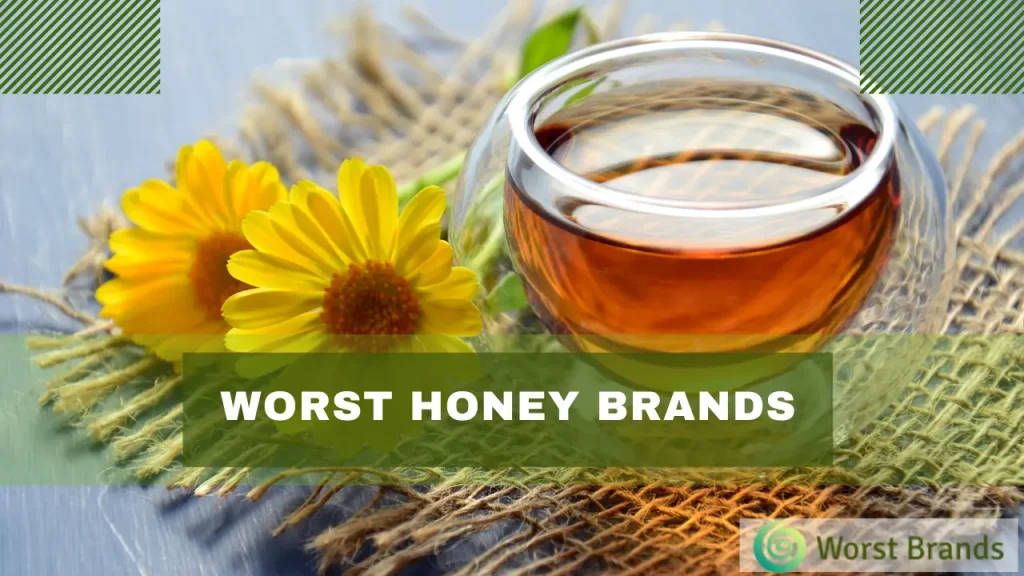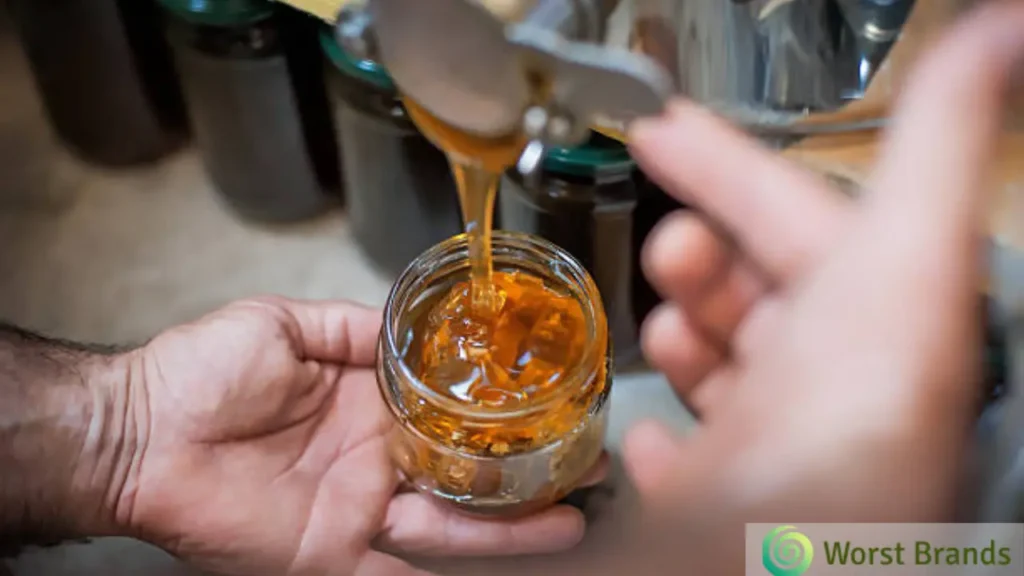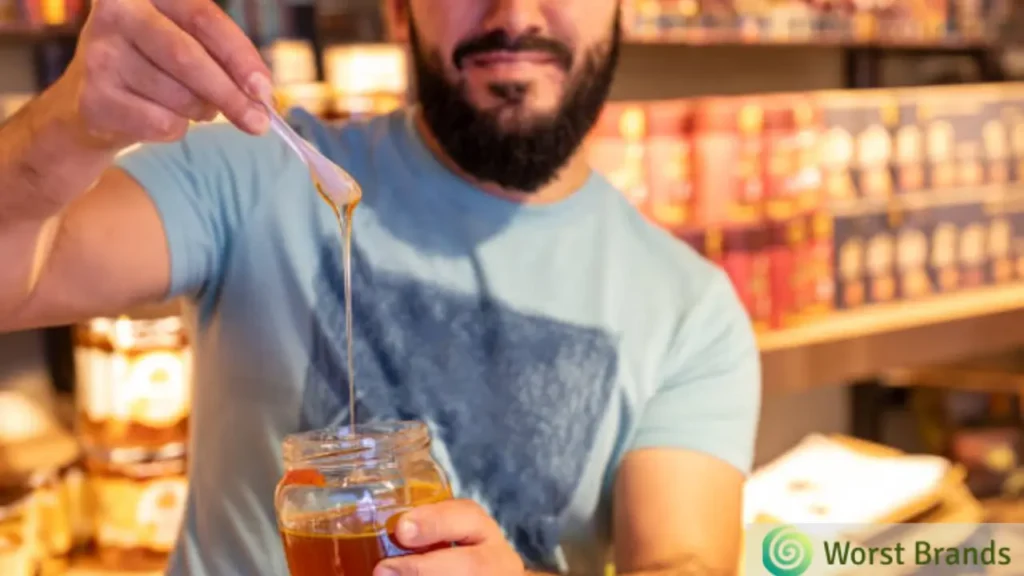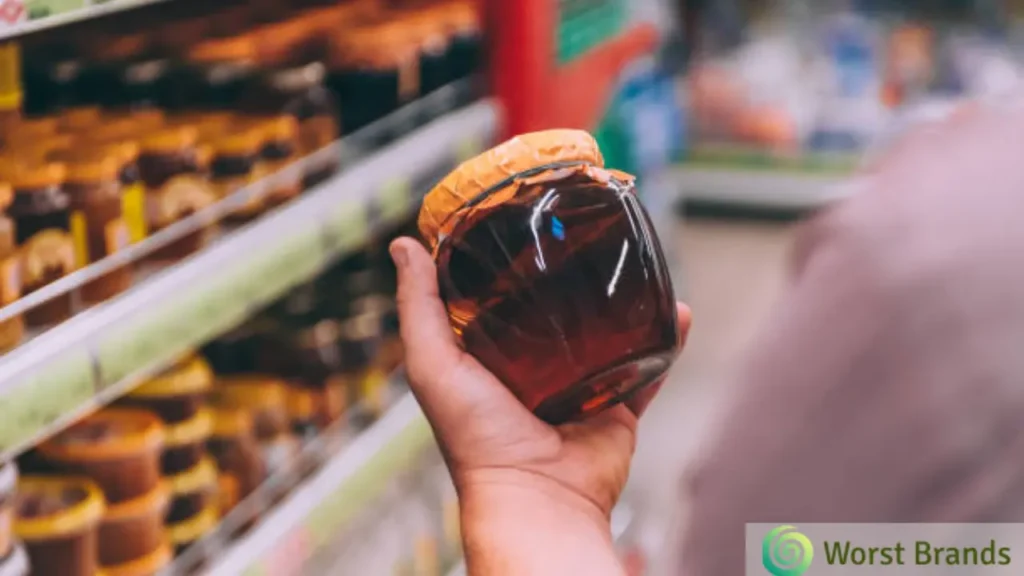Honey is loved worldwide for the sweetness and health benefits it offers. Our ancestors raved about honey being a magic potion that cures almost all health problems.
These include regulating blood sugar levels and acting as an anti-inflammatory agent. But good quality honey that is natural and rich in anti-oxidants is very hard to find.
More often than not, you get influenced into purchasing something that’s more sugar syrup than honey.
After reading this, you’ll be aware of the worst honey brands to avoid. So, without further ado, let’s get right into it.

Table of Contents
How To Identify Fake Honey Brands?
Identifying fake honey brands can be tricky, but with a bit of knowledge and attention to detail, you can easily spot them. Here are some tips from my personal experience:
- Non-Pasteurized, Non-Filtered Labels: Genuine honey contains beneficial bee pollen. Fake brands often remove this by pasteurizing and filtering the honey. Always opt for honey labeled as ‘raw’ or ‘unfiltered’.
- Avoid Added Sweeteners: Authentic honey is naturally sweet and doesn’t need additives. Fake honey often contains High Fructose Corn Syrup or other sweeteners. Always check the ingredient list for any additives.
- Seek Trusted Certifications: The term ‘pure honey’ is often misused. I look for “True Source Certified” honey, which guarantees a reliable and verified source.
- Organic Claims: Real organic honey is rare, requiring an extensive area of organic plants surrounding the hive. Many brands falsely claim their honey is organic. Be skeptical of organic labels unless they have credible certifications.
- Simple Ingredients: The ingredient list of real honey should only contain one item: honey. Multiple ingredients are a sign of a fake brand.
- Aroma and Impurities: Genuine honey usually has a mild, floral scent and may contain natural impurities like pollen or honeycomb bits. A lack of aroma and a too-clean appearance can indicate a fake product.
- Crystallization Test: Pure honey crystallizes over time, while fake honey stays liquid. You can test this by observing if the honey crystallizes after a few days.
Honey Brands to Avoid:
After extensive research, we found Patanjali, Wedderspoon, Cox’s Honey, Nature Nate’s, Happy Belly, Langnese, Beekeeper’s Natural, Bushwick Kitchen, and 365 are the honey brands to avoid that don’t deserve your money.
We are saying this because they have a runny consistency, contain additives, and taste unpleasant.
One major issue is the jars of honey arriving broken or leaking. Now, let’s investigate why we label them the worst honey brands.

1. Patanjali
Baba Ramdev’s brand, Patanjali, is a true example of growth beyond boundaries. Patanjali has earned huge profits in the past years and launched various products.
Patanjali honey is advertised as pure. The brand also says it’s rich in fructose and minerals. But, if we talk about its quality, it’s not very satisfactory. It’s a mix of jaggery and not pure at all.
The unpure nature of the products was further testified by their honey failing the NMR test. It’s a test to crosscheck the purity.
Further, it contains Chinese sugar syrup in the name of organic honey. All the customers noticed it and were furious about paying for adulterated honey.
Honey is usually considered sodium-free. But this one includes 20mg of sodium per 100g of sugar.
People already consume a lot of sodium in their diets, so this amount is unnecessary.
Another major concern was that people received expired products mainly. If they weren’t expired so instead, they were very close to expiry.
Plus, white fungus appeared on some batches of their honey. Imagine paying for a jar of honey that grows fungus on it. It looks like an issue only one of the worst honey could have.
Reasons to Avoid:
- Watery consistency
- Poor packaging leads to leakage
- Becomes smelly
2. Wedderspoon
Wedderspoon prides itself on presenting New Zealand’s Manuka honey to the world.
This brand also claims to practice sustainable harvesting. So, let’s look at what their honey has to offer.
Honey lovers pointed out that their honey isn’t flavorful at all. They have built a bland taste in their honey. Some even say it tastes like licking flowers.
Plus, people reported allergic reactions to their honey. A woman mentioned she got hives on their skin. Upon consultation with a doctor, she was sure it was due to the honey.
Tests conducted by New Zealand labs indicated 8.2 non-peroxide and total peroxide activity. This value should be above ten, so that describes the poor potency.
Also, Manuka honey is supposed to be UMF tested. Wedderspoon’s honey isn’t UMF tested. They just beat around the bush by displaying information about K factor 16.
A customer weighed their honey, which was less than the quantity promised. It proves their disloyal practices towards their customers.
Reasons to Avoid:
- A beetle was seen floating on honey upon opening the packaging
- It makes LPR reflux the worst.
- Their honey isn’t packaged properly during shipping.
3. Cox’s Honey
Cox’s honey started almost 100 years ago. It resulted from dripping honeycombs that gave the brand’s founder the idea of selling it.
The consistency, color, and taste of their honey raised many questions. It made many customers believe in the presence of corn syrup, one of the reasons why it comes with high honey brands to avoid.
Corn syrup can elevate blood sugar levels. Honey does that, too, but pure honey isn’t detrimental to diabetic patients. However, corn syrup’s extra sweetness is harmful.
Plus, the honey taste isn’t very potent. Many people raised the issue that they must add a lot of honey to get the slightest taste.
Customers mentioned they felt bloated after having this honey. Not only that, but major digestive problems occurred, too.
Also, multiple reviews state that their honey attracted ants. If honey attracts insects, that means it’s not pure. What a shame!
Reasons to Avoid:
- Plastic like taste
- Damaged products received
- Non-returnable honey

4. Nature Nate’s
Imagine changing your name to Nature Nate because of your love for nature. It is what happened with its founder.
His love for nature thrived through his businesses, which included selling honey. They deserve appreciation for their efforts toward bee health, especially their focus on bee health research.
But, there are some reservations people have about their honey. Customers are curious about their ingredients as they experience stomach aches.
Nature Nate was pointed out as not being pure. In this regard, a class-action lawsuit was filed against them.
People were mad at the brand for mentioning themselves as pure but not being pure.
Also, their honey includes potentially harmful ingredients like HMF (Hydroxymethyfurfural). It can cause cancer, and so worries many people.
Plus, the packaging is a big pain, too. It is so poorly done that it leaks a lot. Not only that, but the flip-top cap is hard to take off.
Another major concern is that Nature Nate’s honey doesn’t blend well when added to some dishes. It doesn’t blend well in yogurt.
Reasons to avoid:
- Smokey flavor
- Runny consistency
- Very crystallized, making it difficult to consume
5. Happy Belly
It is an Amazon brand. Happy Belly claims to offer food at affordable prices without compromising on customer demands.
Their honey collects oil if you leave it outside the jar for some time. It sure is a weird feature and unappealing for consumers, too.
Someone reviewed the honey that they bought for their beehives. To our surprise, the person mentioned all their bees died after using this. So, how can one be sure if it’s safe for human consumption?
The caps of their bottles are thin. Plus, sometimes it arrives broken, which creates a mess.
Also, Happy Belly honey has an ammonia aftertaste. Nobody enjoys feeding on honey that tortures their taste buds.
Reasons to Avoid:
- It doesn’t taste like Wildflower raw honey
- Caused breakouts in people
- Hard to get out of the bottle
6. Langnese
Langnese’s history can be traced back to 1925. It started when an importer bought 500 kg of Californian honey and began trade.
Their pure bee honey, present in a 6-sided jar, deserves praise for the packaging. It looks very aesthetic and clean.
Now, there are a few issues with this brand, too. Crystallization is a good thing when it comes to honey. But it should be to the extent that it’s edible, and that’s not the case with Langnese.
Another major turn-off is their replacement policy, which sucks. People said they always return honey jars when they feel they got the wrong batch. But Langnese doesn’t let them do that.
Also, false advertising by Langnese proved to be problematic. People expected a set of 10 jars but received one and were utterly disappointed.
Alongside advertising, they make profits through fraud, too. Customers reviewed that they paid for 1 kg bottles but received 500 gm bottles.
Reasons to Avoid:
- It doesn’t taste natural
- Products close to expiry
7. Beekeeper’s Natural
They offer an endless variety of products. From B. Powered Superfood Honey to their nasal spray with propolis, they have huge diversity in their products.
However, honey products are not Beekeeper’s Natural’s forte. One of their honey is chocolate-flavored and doesn’t sit well with most palates.
They have been getting a lot of limelight ever since Kim Kardashian and Kylie Jenner publicly disclosed that they use these.
But, customers were frustrated when they learned about their honey’s hard-as-rock consistency. People said they are so hard you have to dig in.
Also, their honey causes allergies in some people. Although their honey is unadulterated, some ingredients don’t suit people.
The Propolis spray didn’t have propolis, and their honey batches had clashing colors. It puts off the customer as they expect a certain product every time.
Reasons to Avoid:
- Smashed jars received
- Molds grow in their honey

8. Bushwick Kitchen
Bushwick Kitchen’s founder accepted the challenge of setting up a business from scratch in just 30 days. He was successful in winning this challenge.
His success was due to the Bees Knees Spicy Honey becoming a favorite with time. Despite the success, some reviews seem unsatisfied.
People frequently complain about how hot the Bee’s Knees are. The spicy honey is so spicy that it burns their mouths. They should tone down the spice a bit.
Also, squeezing the product out of the nozzle is very hard. You have to apply a lot of strength to get a line of honey.
Further, the quantity in their bottles is less than it should be. Since Bees Knees Spicy honey is consumed in many dishes, buying it repeatedly is difficult.
After a few months of opening, the texture of the product changes. It changes so that it’s hard to understand what went wrong.
An explanation for the texture getting spoiled is the shorter shelf life. Many people suspected this.
Reasons to Avoid:
- Mold in a bottle
- Lemon with honey flavor has no trace of lemon
9. 365
365 is a brand by Whole Foods. It is a popular food store in America and was the first nationally certified organic grocer in the USA.
Considering that 365 belongs to Whole Foods, we had high expectations with this one.
But, sadly, it failed to acquire the approved status. The honey had a syrup-like finish and a darker color than expected. Its syrup-like finish indicates that it doesn’t contain all bee pollen. Sigh!
Another odd feature was the wood glue-like smell. It was so strong that people had to throw the product away.
A lawsuit was filed against 365 by the customers that proved their non-credibility.
The brand marketed the wrong ingredients in their honey crackers and included controversial ones.
365’s honey is hardened and clumpy. Honey is enjoyed due to its texture and consistency, so the hardness caused a lot of trouble for the brand.
Reasons to Avoid:
- Cheap packaging
- Never crystallizes
How to Identify Fake Honey Brands?
Related:
Conclusion:
Honey can be added to water to cure a sore throat or brighten your mornings by sweetening your cup of tea. So, it’s essential for your day-to-day needs.
But now that you know about the worst honey brands, choose one that offers pure honey. One major marker of pure honey is that it doesn’t expire.
Once you decide upon a brand, make sure you don’t overconsume it, as it’s not good in large quantities. If you still have any queries, please ask us; we’ll be glad to help.

Crystal Hafley is a dedicated writer and content creator for WorstBrands, where she specializes in writing insightful reviews about kitchen appliances and fashion products.
With her expertise, Crystal provides readers with accurate and reliable information to help them make informed decisions about the brands and products they use every day. When she's not researching or writing, Crystal enjoys cooking and exploring the latest fashion trends.
Hi! So, what are the best sources of raw, unheated, biodynamic or organic, or wild honey?
The single best source of raw, unfiltered or organic honey is almost always your local beekeeper(s). They may not be the most convenient to find or to buy from. But, it is usually worth the pursuit.